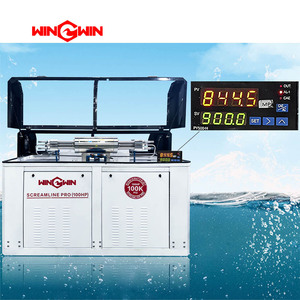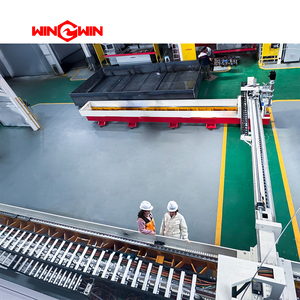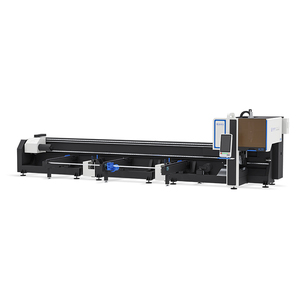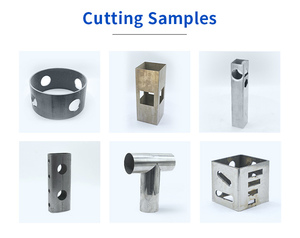
All categories
Featured selections
Trade Assurance
Buyer Central
Help Center
Get the app
Become a supplier

(17173 products available)


























Market Overview: The cutting water jet machine market has demonstrated robust growth, reaching an estimated size of USD 1.15 billion in 2023. Projections indicate a substantial increase, with expectations to reach USD 1.81 billion by 2032, reflecting a compound annual growth rate (CAGR) of 5.17% during the period from 2023 to 2032, according to Research and Markets. This growth is largely driven by rapid industrialization and the increasing adoption of these machines in sectors such as automotive, aerospace, and electronics. The technology's ability to cut various materials without thermal distortion has made it a preferred choice for manufacturers looking for precision and quality.
Industry Insights: The versatility of cutting water jet machines allows them to address a wide range of applications, from automotive components to intricate decorative fittings. In 2024, the market is expected to grow further, with a projected size of USD 1.60 billion, driven by a strong CAGR of 8.21% leading to USD 2.58 billion by 2030, as reported by 360iResearch. Consumer behavior is shifting towards more sustainable manufacturing practices, and cutting water jet machines align well with this trend due to their minimal waste and energy consumption. Furthermore, advancements in technology, such as the integration of robotic systems and 3D cutting capabilities, are enhancing the functionality and appeal of these machines, making them indispensable in modern manufacturing processes.
Cutting water jet machines are classified into five key categories. They are distinguished based on cutting pressure and water jet complexity.
Ceramic Water Jet Pump
This pump has a waterjet cutting system that employs a ceramic intensifier. The ceramic used for the pump's plunger and cylinder is a very hard and wear-resistant material. This makes it suitable for long-term, high-pressure operations without frequent wear or maintenance. This pump is, therefore, very durable. While it supports 60,000 to 90,000 psi. This means it can be used for all high-pressure cutting applications. Such applications include cutting very rigid materials, such as steel, titanium, and hard stones. These materials require precise, high-pressure water cutting to ensure clean, accurate cuts.
Direct Drive Water Jet Pump
A direct drive pump has a motor directly connected to the pump's crankshaft. It is a cost-effective option suitable for low to medium-pressure cutting tasks. Such tasks include cutting softer materials like rubber, foam, or thin metal sheets. These are usually non-industrial uses. The piezoelectric water pump is hassle-free. One simply needs to plug and play. There is no need for additional motor systems to power it up.
Flywheel Water Jet Pump
A flywheel pump has a flywheel that helps even out the pressure. This helps to create a steady and reliable water jet. It is suitable for medium-pressure applications where consistent power is an important factor. Here, power fluctuations must be avoided during long cutting operations. These applications include cutting composite materials, thick metals, or glass. These, which must be cut without risking damage from uneven cutting pressure.
Intensityx Water Jet Pump
This water jet pump is used mainly for abrasive water jet cutting. The intensityx IS pump incorporates a patented pressure-boosting design. This design allows it for ultra-high-pressure cutting, utilizing a pressure range of 60,000 to 94,000 psi. This makes it ideal for cutting extremely tough materials like hardened steel, glass, and granite. These all require the maximum pinpoint pressure and cutting speed.
Plunger-Type Water Jet Pump
The plunger type involves a high-pressure piston that is driven by a low-pressure piston. This makes it generally robust and suitable for high-pressure abrasive water jet cutting. These high-pressure water jets allow cutting the hardest materials. These include metals, stones, and thick glass. All require the powerful pressure of a water jet to cut precisely without damage.
Metalworking
A water jet cutter is used by industries to cut any materials precisely and cleanly, especially hard metals such as steel, titanium, and aluminum. Unlike other cutting methods, such as laser cutting, there is no heat-tinged edge. This makes them ideal for intricate designs where exact cuts are needed. Further, there is no alteration of the internal structure of the material. So their properties remain the same. All these benefits have made water jet cutting common in automotive manufacture, aerospace, and machinery industries.
Stone and Tile Cutting
A significant feature of water jet cutter machines is that they can cut through hard materials like granite, marble, and quartz. These stones are difficult to work with using standard power tools. This is because they are prone to cracks and chipping. However, these water jets take advantage of the fact that these materials can withstand high-pressure water as they precisely carve countertops, tiles, and monument designs. There are also abrasive tips designed for these stonecutting projects, which further enhance their precision and smoothness.
Glass and Ceramics Processing
Glass and ceramics are quite fragile materials that easily break when being cut by traditional methods. It is, therefore, cutting water jet machines that offer a more controlled approach with just little cutting force needed. It allows cutting whatever shape desired while minimizing breaking, chipping, or cracking. Water jet cutters are commonly used to make stained glass windows, display cases, tiles, and ceramic art. Another point that adds to their popularity with glass and ceramic industries is that it can also cut tempered or laminated glass, which is usually very difficult to manage.
Aerospace and Defense
Water jet machines are widely used in the aerospace and defense industries to cut materials such as aluminum, carbon fiber, and stainless steel. These materials are usually needed for aircraft parts and military-grade equipment. Water jet cuttings offer high precision and will not induce heat into the materials. This assists them in maintaining their mechanical properties. These parts typically have stringent tolerance and quality requirements, which make water jetting an ideal solution for them.
Signage and Decorative Cutting
Water jet cutting is widely used in the making of custom signage and decorative art cutoffs from various materials. These include metals, plastics, and woods. Its ability to cut detailed designs with smooth edges makes it ideal for creating intricate patterns, logos, and shapes for commercial and artistic uses. In fact, water jet machines offer great versatility. They can switch from cutting industrial materials to creating artistic projects as per user convenience.
Precision Cutting
Water jet machines provide highly accurate cutting with tolerances as tight as ±0.001 inches. This precision enables intricate designs and tight fittings essential in industries like aerospace, automotive, and electronics. They achieve this by forcing the water through a narrow opening in a cutting head. This narrow opening is called a nozzle.
Abrasive and Non-Abrasive Cutting
Water jet machines then make it possible to cut a wide range of materials from soft ones like foam and rubber to hard ones like metal and stone. Non-abrasive cutting only uses pure water. This is ideal for softer materials like paper and plastics. But for harder materials, an abrasive cutting add-in is needed. Here, powdered garnet mixed with water is used as an additional material. It helps enhance the cutting efficiency over hard materials.
Material Versatility
Water jet machines can cut a large spectrum of materials as listed above. These include metals, stones, glass, and composites. They do it all with remarkable ease. They can handle thicknesses of up to 8 inches. This versatility makes them ideal in various industries that need different cutting services.
Edge Finish and No Heat-Affected Zone (HAZ)
Water jet machines leave a smooth edge on cut materials. Usually, there is no need for secondary finishing like sanding or polishing. This is because of their clean-cut nature. They also do not induce any heat into the material during cutting. This helps prevent warping, burning, or altering of the material's internal structure. These would otherwise occur with methods that employ heat, such as laser or plasma cutting.
Minimal Waste and Environmental Considerations
Water jet cutting produces very little material waste. This is because it can make very closely packed cuts, maximizing the use of each material sheet. Further, it is also rather environmentally friendly. The process uses only water and garnet as its primary inputs. These are both very affordable and quite easily sourced. It also generates no harmful fumes or gases. This makes it less pollutant compared to many other cutting methods. All these contribute to a sustainable operating profile that is eco-friendly.
Water Jet Machine Material
It is prudent to consider what materials the cutting machine can handle. There are two types of cutting water jet machines. These are abrasive jet machines and pure waterjet machines. Pure water machines are meant for softer materials such as rubber, foam, and plastics. However, abrasive jet machines are meant for harder materials like metals, glass, and stones.
Cutting Head
Further, one can opt for a machine with a dual cutting head. This will allow the user to complete different tasks at the same time. There are also machines that have a multiple or interchangeable nozzle. These make them suitable for different thicknesses for a single cutting head.
Software Compatibility
The cutting water jet machines use computer numerical control (CNC), Just like other cutting machines. Ensure the machine has design software that is compatible with that of other cutting machines. This will allow the user to switch materials or scale designs without the need of starting the design all over again.
Power
While choosing cutting machines, people often consider the machine's motor power. Here, one should consider the pressure of the waterjet. This is because, with more pressure, the jet will be able to cut thicker materials. Different machines have different ranges of pressure. Pure water machines have a pressure range of 8,000 to 55,000 psi. While abrasive water machines, have a water pressure of about 94,000 psi.
Maintenance Requirements
Just like any other product, make sure to research the maintenance needs of the cutting water jet machine. Some machines may require frequent services. While others are just simple to maintain. Frequently serviced machines may hamper work schedules. Again, some machines may use more readily available parts than others. These would be easier and less expensive to maintain.
Cutting water jet machines are usually used in industries that require cutting customized materials. These industries include the automotive, aerospace, construction, and manufacturing industries. They cut materials with varying thicknesses and types. These types include metal, glass, stone, and composite materials. They achieve precise cuts and intricate designs without the heat affecting these materials.
Water jet cutting machines are comprised of five major components. These are the pump, work table, cutting head, nozzle, and abrasive mixing tube. The pump is responsible for pressurizing the water. There is a high-pressure pump that can generate up to 94,000 psi of pressure. The work table holds the material that is being cut. The cutting head is where the high-pressure water exits. The nozzle is the opening through which water flows. This is where water is concentrated to form a jet. The water then mixes with abrasive in the mixing tube to enhance cutting capability.
The operation of water jet cutting machines begins with applying the water. Here, a highly pressurized stream of water is forced through a nozzle by a pump. The water then turns into a jet. If there is an abrasive jet machine, the water will mix with abrasives in the nozzle. The jet then will be directed toward the material that needs to be cut. The material will move closer to the jet until it is pierced. The motor will then move the jet across the material-cutting line. The cutting head will follow the predefined path to complete the cut. The jet cutting will stop once the cut is complete.
Cutting water jet machines have seven key advantages over traditional cutting techniques. They can handle a huge variety of materials, from delicate glass to solid metal. They use no heat, eliminating the risk of burning or warping. They also cut thick material up to 8 inches in a single pass and further don’t require finishing. All these combine to produce no noxious gases. So, they are environmentally friendly. Lastly, they have operational safety due to hazards like burning or electric shocks.